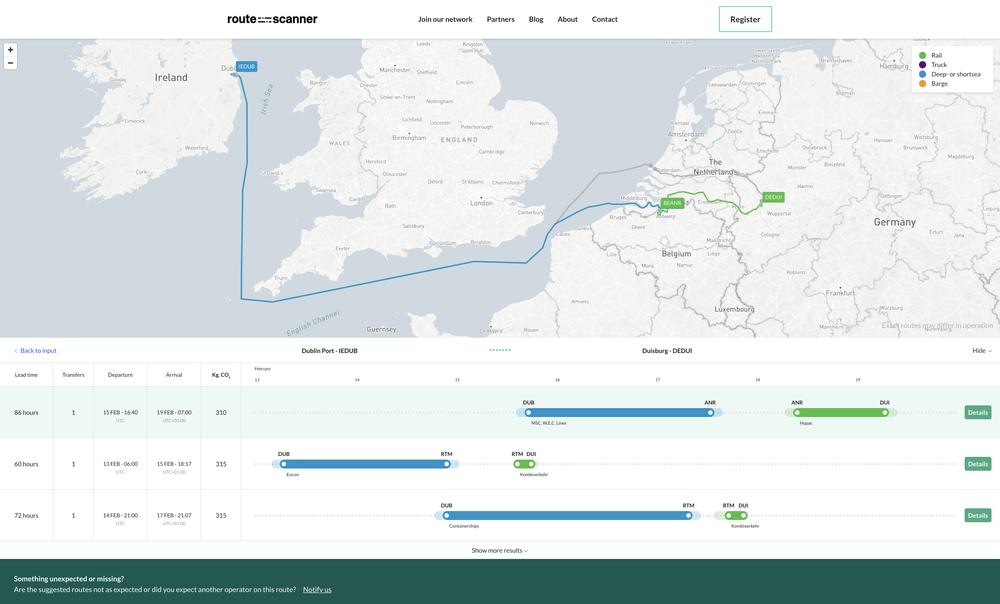
Modal shift in logistics: unlocking reliability, sustainability, and resilience through smarter transport choices
Global supply chains are under increasing pressure. Delivery delays, traffic congestion, and port bottlenecks are making logistics more unpredictable and expensive. Add to that rising fuel prices and tightening environmental regulations, and it becomes clear: relying solely on road transport is no longer a sustainable option.
One of the most effective responses? Modal shift. Moving freight from road to more sustainable alternatives such as rail, inland waterways, or short-sea shipping. This strategic shift can unlock major benefits in reliability, sustainability, and resilience across your logistics operations.
Why modal shift is gaining momentum
Modal shift isn’t just about reducing emissions. It’s a smart, proactive response to several growing logistics challenges:
- Unreliable delivery times due to congestion and roadworks.
- Port congestion resulting in delays and missed connections.
- Driver shortages increasing operational costs.
- Single-mode dependence, which heightens risk.
- Sustainability demands from regulators and stakeholders.
- Fuel price volatility, especially with ETS2 on the horizon.
ETS2: What’s coming
In 2027, the EU Emissions Trading System (ETS2) will be extended to include road transport. Fuel suppliers will need to purchase carbon allowances, which is expected to raise diesel prices by €0.10 to €0.30 per liter, up to a 20 percent increase. For logistics operators, this translates to higher costs and even stronger incentives to explore low-emission alternatives.
What is modal shift?
Modal shift means switching freight from high-emission transport modes like trucks or air freight to more sustainable ones. Rail, barge, or short-sea shipping. It helps logistics teams:
- Reduce CO₂ emissions.
- Improve delivery reliability.
- Lower transport costs.
- Increase supply chain resilience.
Business benefits at a glance
Environmental impact
- Rail and barge can reduce CO₂ emissions by up to 400 percent compared to road freight.
- Fewer trucks on the road improves air quality and reduces congestion.
- Lower emissions support public health and help meet ESG targets.
Operational efficiency
- Multimodal transport can save over 90 minutes per trip via reduced congestions in ports and along the way, as well as a reduced need for truck drivers.
- Optimized last-mile trucking reduces empty run length and boosts fuel efficiency.
- A more diverse modal mix increases flexibility and lowers disruption risk.
Smarter use of road transport
- Trucks focus on efficient short-haul legs.
- Idle time and long-distance dependency are minimized.
- Driver recruitment and planning become easier.
How Routescanner makes modal shift actionable
Modal shift only works when it’s backed by accurate, real-time data. That’s where Routescanner comes in.
Our platform allows logistics teams to compare container transport options across all modalities. Not just on cost or transit time, but also on emissions and route performance. Instead of relying on fragmented sources, you get structured, standardized insights in one place.
Key features
- Global route comparison: Access data from more than 288 connected operators.
- CO₂ insights: Visualize emissions for every route.
- Terminal proximity: Identify nearby rail or barge terminals.
- Scenario planning: Test modal combinations to find the best fit.
Real-world example
Imagine you’re moving containers from an inland distribution center to a seaport. Traditionally, this would be handled by truck alone. But with Routescanner, you discover:
- A rail terminal just 20 kilometers away.
- A barge route that bypasses 150 kilometers of congested roads.
- A multimodal option that saves two days in transit and cuts CO₂ by 60 percent.
With ETS2 raising diesel costs, this isn’t just the greener route. It’s also the most economical.
At a glance: the benefits
| Benefit | Impact |
|---|---|
| Greener transport | Up to 400% less CO₂ emissions |
| Less congestion | Fewer trucks and reduced port traffic |
| Faster delivery | 90+ minutes saved per trip |
| Truck efficiency | Shorter legs, fewer empty runs |
| Terminal proximity | 59% of zones within 30 min of a terminal |
| ETS2 savings | Avoid €0.30/l diesel cost increase |
| Smarter planning | Compare routes by cost, time, emissions |
Final thoughts
Modal shift is no longer just an environmental initiative. It’s a strategic response to the challenges of modern logistics. With Routescanner, you have the tools and data to make smarter routing decisions that improve reliability, cut emissions, and strengthen your supply chain.
Whether you're a shipper, freight forwarder, or supply chain manager: smarter, greener, and more resilient transport starts here.
Next time you plan a shipment, ask yourself: is there a better way to move this container? Chances are, there is. And it starts with a shift.
More from the blog

Routescanner: your decision support platform

Modal shift gains momentum in the UK: Insights from Multimodal 2025

Procurement reimagined: strategic tendering in container logistics
Stay in the loop
Discover how our network of shippers, forwarders, operators and terminals is growing.
Subscribe to our updates